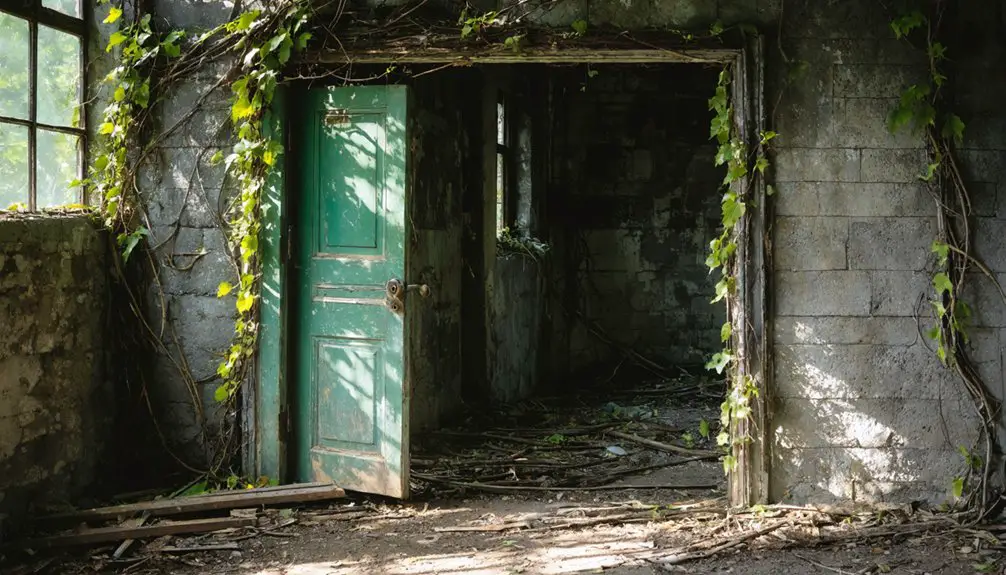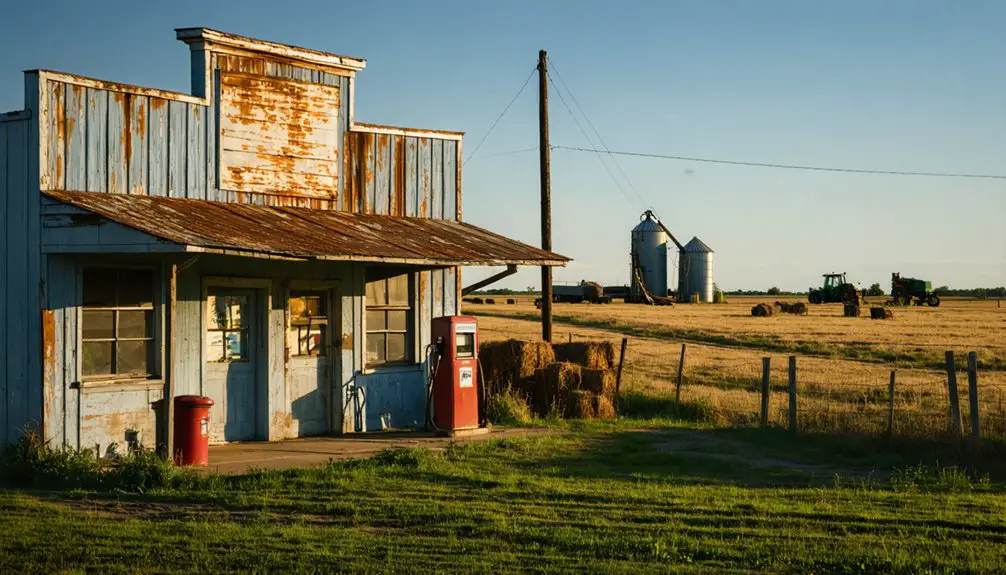You’ll find Diamond, Oklahoma in the state’s panhandle region, where W.D. and Ethel Diamond filed an ambitious town map in 1910 hoping to create a diamond-mining boomtown. Despite their grand vision and initial infrastructure development, the town couldn’t compete with neighboring communities that offered more stable economies. The harsh plains environment and scarce water sources contributed to its downfall. Diamond’s story mirrors many Oklahoma ghost towns, where frontier dreams collided with harsh realities.
Key Takeaways
- Diamond was established in 1910 by W.D. and Ethel Diamond as a planned mining boomtown in Oklahoma’s Texas County.
- The town’s prosperity was short-lived due to unrealized mining potential and competition from neighboring communities with stronger economies.
- Geographic isolation and harsh environmental conditions, including water scarcity, contributed to Diamond’s eventual abandonment.
- Physical remnants include crumbling foundations, abandoned structures, and deteriorating streets overtaken by dead foliage and weeds.
- The ghost town serves as a cautionary tale about single-industry planning and the importance of sustainable economic development.
The Failed Dream of Diamond’s Founders
When W.D. and Ethel Diamond filed their ambitious town map in January 1910, they couldn’t have foreseen how quickly their dreams of a diamond-mining boomtown would crumble. The founders’ vision was bold – they’d create a thriving community centered around diamond mining, drawing settlers and businesses to stake their claim in Oklahoma’s promising frontier.
You can trace their initial optimism in the rapid town planning and infrastructure development they championed. Like many entrepreneurs of their era, they believed they’d struck it rich. Following the pattern of Oklahoma’s resource-based boomtowns, Diamond’s founders hoped to capitalize on the region’s natural wealth. The town’s fate echoed that of oil boom communities like DeNoya and Three Sands, which vanished after economic downturns.
But their mining aspirations soon hit harsh reality. The diamond deposits proved too scarce to sustain operations, and investor confidence plummeted. Despite their efforts to promote the town and attract settlers, Diamond couldn’t compete with neighboring communities that offered more reliable economic foundations.
Location and Geographic Features
The ghost town of Diamond stands in Texas County, nestled within Oklahoma’s Panhandle region – an area once known as “No Man’s Land.”
While Diamond’s mining ambitions failed to materialize, its geographic setting proved equally challenging for long-term survival.
You’ll find Diamond amid flat, rolling plains where harsh summers and scarce water sources created significant agricultural challenges for early settlers.
The town’s geographic isolation intensified after the decline of the railroad that once served as its lifeline.
Today, you’ll need to navigate dirt and gravel roads to reach what remains of Diamond, surrounded by vast stretches of dryland farming and cattle ranches.
Like nearby Hardesty’s railroad decline, Diamond’s landscape tells the story of a frontier settlement that couldn’t overcome the unforgiving nature of the Panhandle’s semi-arid environment.
The town sits about five miles from the historic Mouser settlement, sharing a similar fate of abandonment along the defunct rail line.
Timeline of Diamond’s Short-Lived Existence
Diamond’s brief existence followed a familiar pattern seen across numerous Oklahoma boomtowns of the early 1900s.
The ephemeral rise and fall of Diamond echoed the destiny of countless Oklahoma towns during the early twentieth century’s boom era.
You can trace the town’s rise and fall through a predictable sequence: swift establishment during an economic boom, followed by Diamond’s allure drawing initial settlers and businesses with promises of prosperity.
The town experienced transient prosperity, likely lasting mere months or a few years at most. Like Kusa Industrial newspaper documented for other towns, Diamond’s early development was marked by optimistic reports of progress and potential.
Similar to how lead and zinc mining dominated neighboring regions in the late 1800s, Diamond sought to capitalize on local mineral resources.
Basic services and community structures emerged, but the boom quickly faded when resource prospects or transportation dreams failed to materialize.
As financial backing withdrew and residents sought opportunities elsewhere, Diamond’s decline accelerated rapidly.
Why Diamond Never Materialized
You’ll find that Diamond’s ambitious economic vision collapsed before it started, as investors vastly overestimated the region’s commercial potential while ignoring its proximity to the declining mining town of Picher.
The proposed town’s location proved especially problematic, sitting squarely within the toxic reach of Picher’s contaminated chat piles and unstable mine shafts. The area had been extensively mined since lead and zinc were first discovered in 1913.
Diamond’s planners had fatally overlooked these environmental hazards that would ultimately make the site uninhabitable, mirroring the same issues that forced Picher’s evacuation. After all, studies had shown that 34% of children in the area had dangerously high levels of lead in their blood.
Failed Economic Projections
When initial surveys suggested vast mineral deposits in the area, speculators rushed to establish Diamond as Oklahoma’s next boomtown – but their economic projections proved wildly optimistic.
Poor economic forecasting led investors to overestimate both the longevity of mineral deposits and the scale of population growth needed to sustain the town. Similar to many settlements that became ghost towns, Diamond’s existence was tied to resources that could no longer sustain it.
Like many towns that experienced oil booms, Diamond’s rapid development was fueled by unrealistic expectations of endless prosperity. Resource mismanagement compounded these problems as developers built extensive infrastructure for a population surge that never materialized.
You’ll find that Diamond’s fate was further sealed by fierce competition from neighboring towns and shifts in transportation routes that diverted trade elsewhere.
When commodity prices dropped and extraction costs rose, the town’s single-resource economy couldn’t adapt.
Environmental concerns and mounting cleanup costs delivered the final blow, turning Diamond’s dreams of prosperity into another Oklahoma ghost town.
Poor Location Planning
Despite initial optimism from town founders, the poor location planning of Diamond sealed its fate before construction even began. A proper site assessment would have revealed major flaws in the town’s positioning, far from essential transportation routes and natural resources that could have sustained growth.
- You’ll find Diamond’s isolation was particularly devastating – with no railroad access and poor road infrastructure, the town couldn’t compete with better-situated settlements that attracted commerce and settlers.
- The site’s resource availability proved inadequate, lacking reliable water sources and quality farmland that pioneers needed to establish lasting communities.
- When neighboring towns relocated closer to railroad lines, Diamond’s founders failed to adapt, clinging to their original location while watching potential residents and businesses choose more accessible communities.
Physical Remnants and Current State

Although little detailed documentation exists of Diamond’s current physical state, the abandoned mining town likely mirrors the fate of similar Oklahoma ghost towns, with minimal structural remains and extensive environmental deterioration.
If you venture there today, you’ll find abandoned structures marked with “Keep Out” warnings, their frames weakened by decades of neglect. The landscape tells a story of industrial decline – crumbling foundations peek through overgrown weeds, while mining waste continues to pose environmental hazards.
Streets that once bustled with activity now lie cracked and fading beneath dead foliage and leafless trees. Like nearby Picher, Diamond’s remains face ongoing challenges from ground subsidence and toxic contamination, making much of the area unsafe for exploration or development.
Comparing Diamond to Other Oklahoma Ghost Towns
Many Oklahoma ghost towns share striking parallels with Diamond’s rise and fall, particularly those born from mining and resource extraction.
You’ll find economic trends that mirror Diamond’s story throughout the state, from the coal fields to oil boomtowns.
- Like Adamson, which peaked at 3,500 residents before a devastating mine collapse, Diamond followed the classic boomtown pattern of rapid growth followed by swift decline.
- Similar to Moral and other temperance-focused settlements, Diamond emerged during a time when social values shaped town identities and development.
- Diamond’s fate echoes towns like Kenton and Picher, where environmental and administrative challenges, not just resource depletion, contributed to their abandonment.
These ghost town parallels reveal how Oklahoma’s early communities often faced common challenges that led to their eventual decline.
Economic Impact on Surrounding Areas

While Diamond’s transformation into a ghost town directly impacted its immediate vicinity, you’ll find its economic ripple effects spread throughout the surrounding region in complex ways.
Despite population losses, you’ll notice surprising economic adaptations – median household income rose 75% and poverty levels dropped 25%, suggesting workforce adaptation to new opportunities.
The region’s economic revitalization potential remains strong, particularly through Oklahoma’s Brownfields program, which has shown remarkable success with 137% employment growth on remediated properties.
You’ll see additional economic drivers in the area’s growing tribal economies, which generate billions in regional impact.
The surrounding communities, especially in Tulsa County, maintain a skilled workforce that could support redevelopment efforts, though environmental cleanup challenges must be addressed for sustainable growth.
Legacy and Historical Significance
Though Diamond’s abandoned streets and crumbling structures stand as evidence to failed frontier ambitions, you’ll find enduring lessons about the precarious nature of boom-town development in Oklahoma’s territorial period.
You can trace how shifting economic forces, inadequate planning, and the stark realities of frontier life contributed to the town’s ultimate downfall.
The ghost town’s quiet ruins serve as a powerful reminder that even the most promising settlements couldn’t guarantee survival without sustainable infrastructure and diversified economic foundations.
Failed Dreams, Lasting Lessons
Despite its brief existence as a mining settlement, Diamond, Oklahoma left an indelible mark on the state’s historical landscape as a cautionary tale of frontier ambition and economic fragility.
You’ll find its story woven into the fabric of Oklahoma’s boom-and-bust economic cycles, serving as a stark reminder of the challenges faced by early resource-dependent communities.
- Diamond’s rapid rise and fall mirrors the fate of over 2,000 Oklahoma ghost towns, highlighting the risks of single-industry dependence.
- The town’s abandonment taught crucial lessons about community resilience and the need for economic diversification.
- Its legacy continues to inform modern discussions about sustainable development and resource management in frontier regions.
Today, Diamond stands as a monument to the delicate balance between opportunity and sustainability in America’s heartland.
Planning’s Empty Promise
When Oklahoma’s early town planners sketched their ambitious visions for settlements like Diamond, they painted enticing pictures of modern amenities, bustling commercial districts, and endless prosperity fueled by resource extraction.
Their urban optimism led them to invest heavily in infrastructure before securing sustainable economic foundations, leaving behind haunting reminders of unfulfilled promises.
You’ll find that Diamond’s story mirrors countless other Oklahoma ghost towns where resource dependency proved fatal.
While planners promised theaters, banks, and modern conveniences to attract settlers, they failed to account for the inevitable depletion of natural resources.
The empty streets and crumbling buildings you see today stand as silent witnesses to the dangers of single-industry planning and the harsh realities that shattered dreams of perpetual growth.
Frequently Asked Questions
Were There Any Notable Crimes or Mysterious Events in Diamond’s Brief History?
Beyond wind-swept plains and crumbling foundations, you won’t find documented unsolved mysteries or ghost sightings in Diamond’s history. The town’s story faded quietly with depleted mines, not dramatic crimes.
What Natural Resources or Mining Potential Existed in the Diamond Area?
You’ll find coal was the area’s primary resource, with substantial deposits mined commercially. While gold mining never took off, the region held various mineral deposits including limestone, clay, and construction-grade stone materials.
Did Any Famous Personalities Invest in or Visit Diamond?
A million records searched reveal no evidence of famous visitors or historical investments in Diamond. You won’t find any celebrity connections – the town’s story focuses on local frontier entrepreneurs instead.
What Was the Original Asking Price for Lots in Diamond?
You won’t find documented records of the original pricing for Diamond’s lots. While mining towns of that era typically valued lots based on mineral prospects, exact historical lot values remain unknown.
Were There Any Native American Settlements at the Diamond Site Before?
You’ll find evidence of native tribes in the broader region, but there’s no direct confirmation of settlements at Diamond’s exact location, though historic artifacts suggest indigenous presence in surrounding areas.
References
- https://en.wikipedia.org/wiki/List_of_ghost_towns_in_Oklahoma
- http://files.usgwarchives.net/ok/bryan/history/towns/diamond.txt
- https://www.okhistory.org/publications/enc/entry?entry=GH002
- https://stephentravels.com/top5/ghost-towns/
- https://okmag.com/blog/a-ghostly-site/
- https://www.thevillageok.gov/229/The-History-of-The-Village-by-B-Stone
- https://www.youtube.com/watch?v=1stZe7ukjts
- https://www.youtube.com/watch?v=ipdzN0yrpfE
- https://kids.kiddle.co/List_of_ghost_towns_in_Oklahoma
- https://okcfox.com/news/local/oklahomas-secret-past-ghost-towns-of-oklahoma



